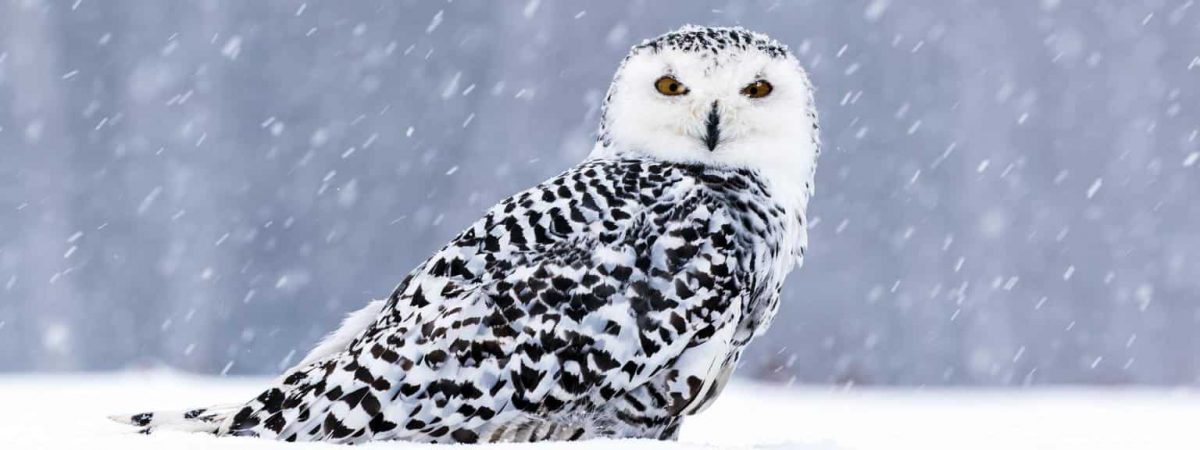
In the state of Alaska, there are 10 different species of owl that can be found.
Table of Contents
ToggleThese 10 species are:
- Barred Owl
- Boreal Owl
- Great Gray Owl
- Northern-Hawk Owl
- Great Horned Owl
- Northern Pygmy-Owl
- Northern Saw-whet Owl
- Western Screech-Owl
- Short-eared Owl
- Snowy Owl
Want to learn more? This National Geographic Book on Owls is a great read!
There are so many different owl species because of the state’s climate.
This climate is an arctic climate, meaning that Alaska has cool summers and long cold winters. Perfect for lots of northern species of owls.
Alaska has a state park system containing 120 units and there are 8 national parks across the state.
Now that we’ve briefly covered why Alaska is a great state for many owl species, let’s have a look at the owls that do reside there in more detail.
Want to attract Owls to your yard? Take a look at our article!
What Owls can be seen in Alaska?
Table of Contents
1. Western Screech Owl
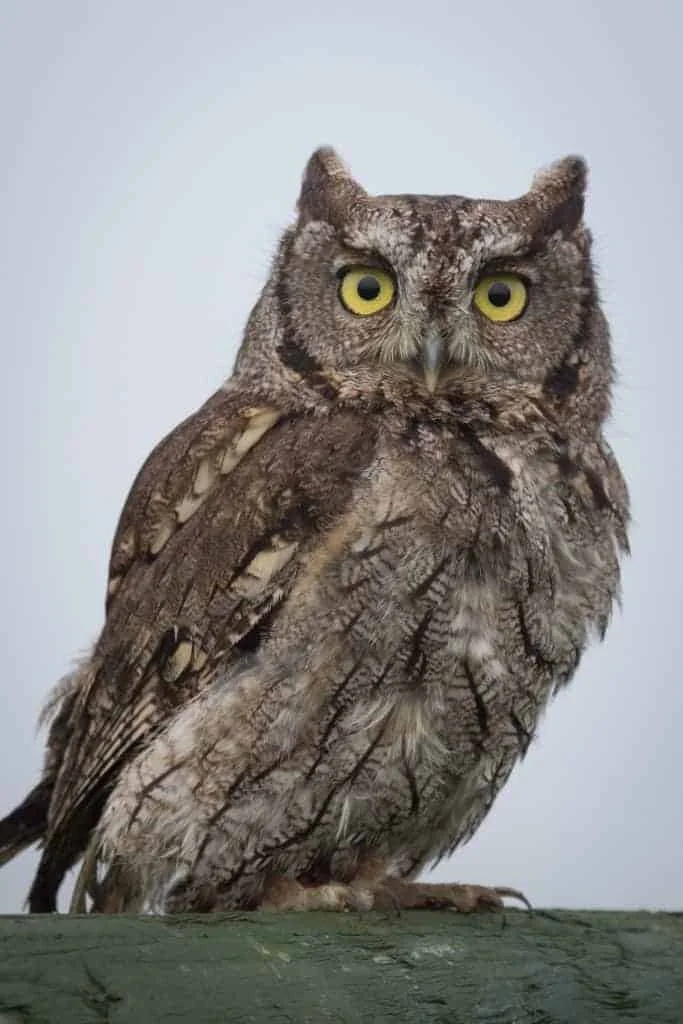
Wingspan
55cm
Weight
143g
Life Expectancy
13 years old
Diet
Insects and small mammals
The Western-Screech Owl has a stocky, small body that is covered with grey feathers.
These birds like to make their nests along the edges of canyons if they can but will commonly nest in open woodland areas as well.
In recent years they have also been observed staying close to urban cities.
Males will stay with a singular female during the breeding season to help her raise the brood, but they will mate with multiple individuals.
When courting a female, a male will bring food to the nest which is usually inside of a natural tree cavity.
Breeding pairs will also sing duets together and will both contribute to protecting the nest. One common bird that tries to disturb their nests is the crow.
These birds are year-round residents in the state of Alaska and can be seen in the southern regions of the state. They have most commonly been sighted along Alaska’s southern border.
2. Great Horned Owl

Wingspan
~140cm
Weight
1.4 kg
Life Expectancy
28 years old
Diet
Squirrels, Rabbits & Skunks
This owl has long pointed ears that look like horns, which is where it gets its name from.
They are covered in feathers that are thick and greyish brown in color and they have a large body.
Great Horned Owls will form long-term breeding pairs and a lot of the time these pairs will stay close to each other outside of the breeding season.
These birds are also monogamous during their breeding seasons. Both members of the breeding pair are very territorial and will defend their territory with a series of sharp hoots.
Fights will often break out and breeding pairs have been known to kill members of their species that stray too close to their nests.
Different bird species, such as small songbirds, will also harass these birds in an attempt to get them to abandon their nests and their eggs.
The Great Horned Owl is present in every state and is a permanent resident of Alaska, it can be seen in all areas of the state.
Most of the recorded sightings of this bird have been in the southeast of the state.
3. Northern Saw-whet Owl
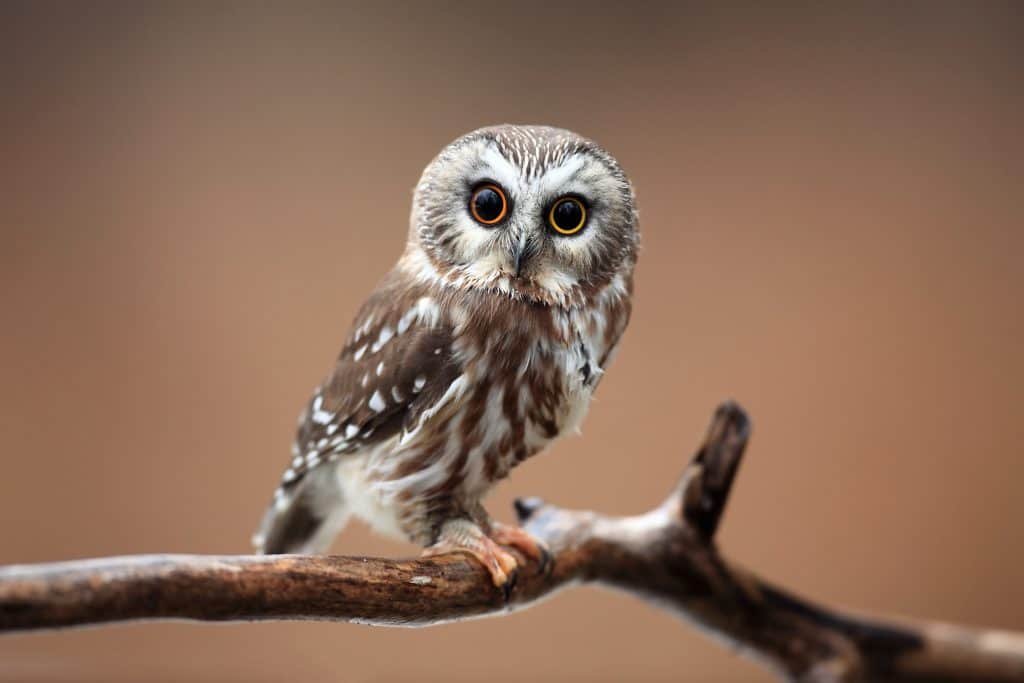
Wingspan
40 - 60 cm
Weight
100 g
Life Expectancy
7 years
Diet
Small birds, young squirrels, voles & shrews
The Northern Saw-whet Owl is one of the smaller species of owl and it is covered in deep brown feathers.
These small owls make their nests in various forest habitats and roost throughout the day.
Males will sometimes mate with several different females during the breeding season, but these birds are primarily monogamous and will form breeding pairs.
Individuals from the breeding pairs will often stay together outside of the breeding season to help each other defend their territory, however, they do not mate for life.
Their breeding season is from the end of January to the beginning of May which is when you will hear their distinct too-too-too mating call.
When a female enters a male’s territory, he will circle around her in-flight 20 times before moving down to her and gifting her with a prey item.
They prey mostly on rodents such as a lemming or a mouse. These birds are often preyed upon by larger species of owls so have to be careful when they are hunting.
These birds can only be seen along with the southern border of Alaska but the ones that reside there are permanent residents of the state.
4. Short-Eared Owl
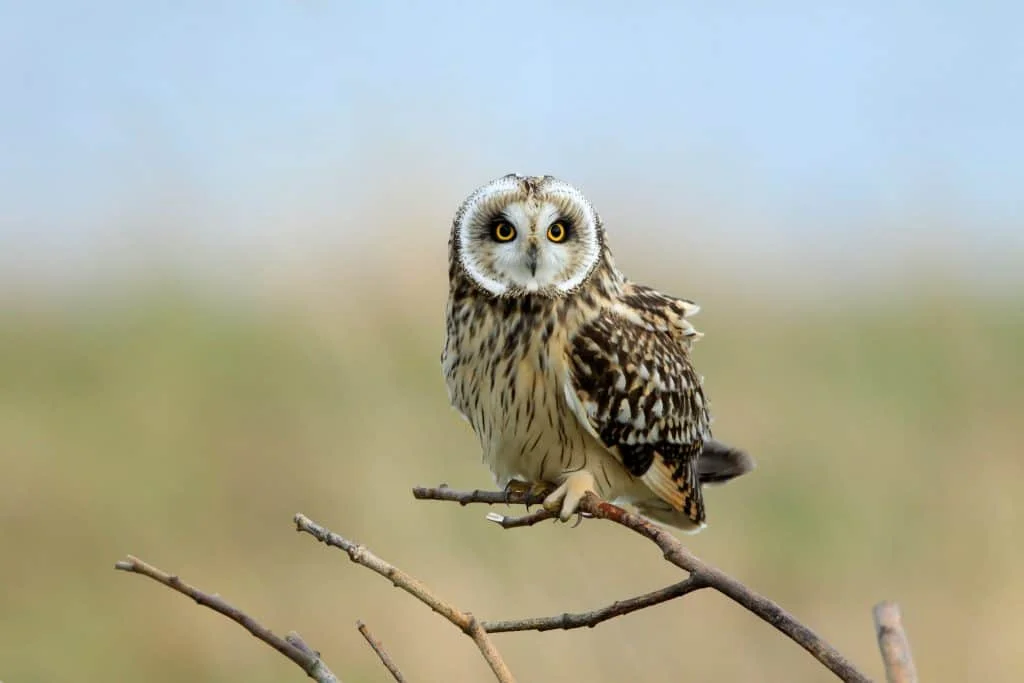
Wingspan
85 to 110 cm
Weight
206–475 g
Life Expectancy
4-12 years
Diet
Voles, Mice, Squirrels
Short-eared owls have ear tufts, but they are barely visible, which is how they got their names.
Their stocky bodies are covered in brown feathers and have patches of white on their bellies.
These owls have adapted to use open woodlands to their advantage and will hunt during the day and the night.
The open areas make it easier for them to spot and swoop down to their prey.
Short-eared owls form breeding pairs and are monogamous during the breeding season, although it is unknown as to whether they mate for life or just for a singular season.
Breeding pairs will make their roosts on the ground in areas of tall grass, they only tend to roost in trees during the winter months especially when it is snowy.
Males will feed the females whilst they are incubating the eggs and will also help defend their territory with a series of harsh calls.
Short-Eared Owls will often form loose colonies of lots of individuals that stay near each other throughout the year, even during the breeding season.
Short-eared Owls can be seen in all regions of Alaska, but they are only present in the state during their breeding seasons.
Most of the recorded sightings of this bird have been in the south easterns regions of the state.
5. Snowy Owl
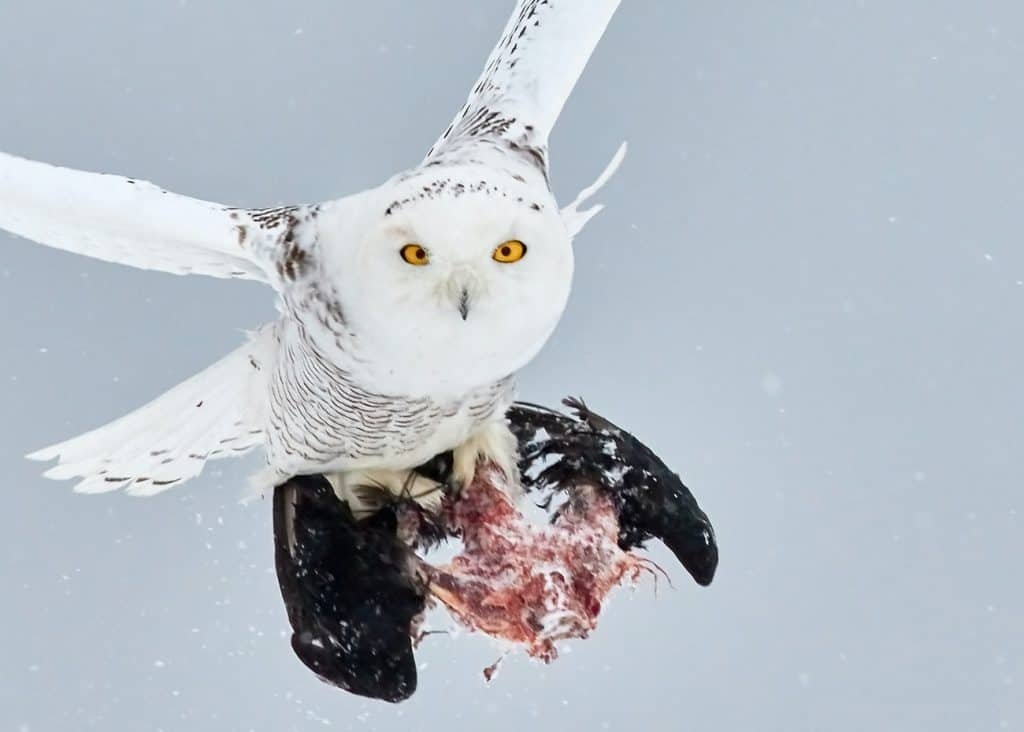
Wingspan
150 cm
Weight
2 kg
Life Expectancy
10 years
Diet
Birds, Rabbits, Fish & Rodents
These owls are covered in layers of thick white feathers and are on the larger side of the owl species.
They sometimes have a unique pattern of speckling black and grey on the tips of their feathers.
You are most likely to see one of these owls in tundra habitats and across open plains, which is why they are more commonly seen in Alaska.
They are very defensive of their territory and are not afraid to get into fights with birds, humans and even in rare cases wolves, that move in too close.
Snowy Owls will perch on high places such as telephone poles to observe their territory and search for prey more easily.
Males have a unique courting display that they do for the females which involves diving rapidly towards the ground with their wings in a v shape.
They will have a small prey item, such as a lemming, grasped in their talons, and will drop it as a gift for the female when they reach close to the ground.
Apart from this, not a lot is confirmed about their breeding behaviors and it is uncertain as to whether they are monogamous or not.
Snowy Owls are much more common in Alaska than in any other state. Some of these owls will be permanent residents but the numbers of Snowy Owls increase greatly in the winter months.
They can be seen throughout all regions of the state but most of the sightings have been recorded in the southern areas of the state.
6. Northern Hawk Owl
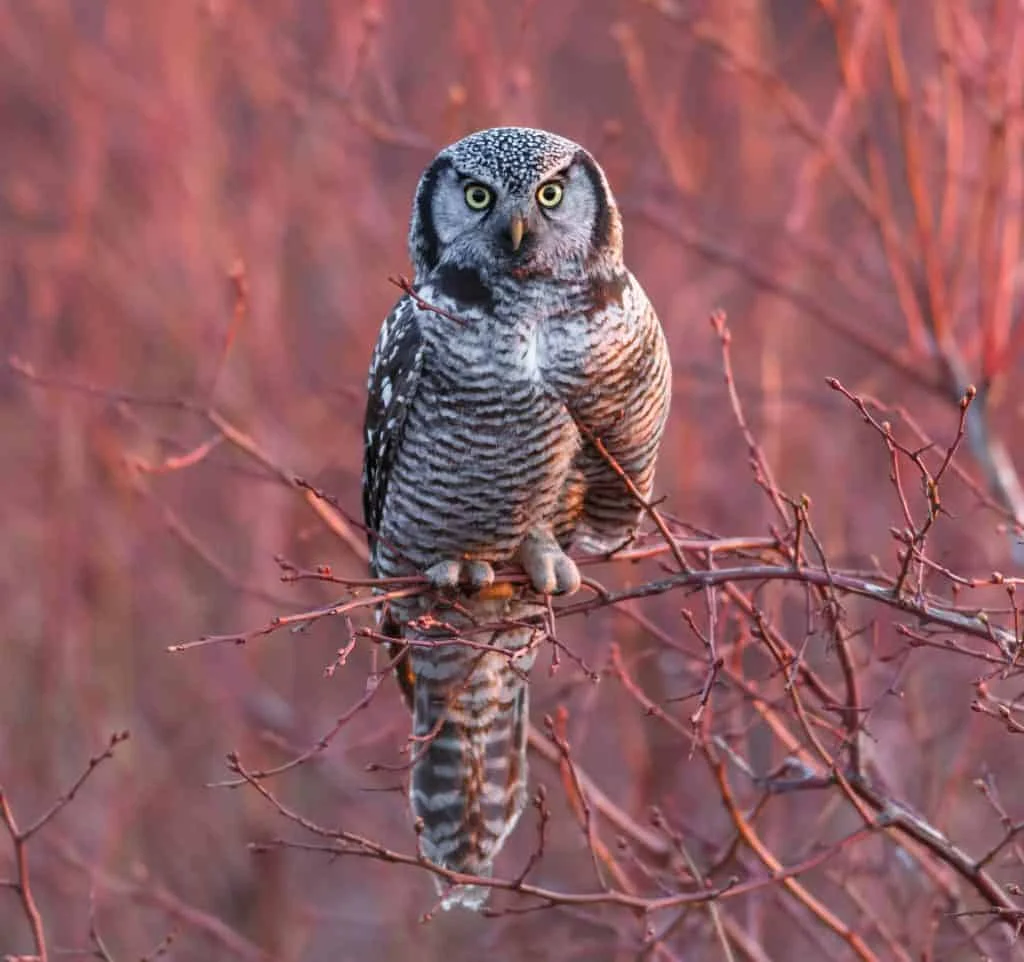
Wingspan
45 cm
Weight
300 -340 g
Life Expectancy
Up to 16 years
Diet
Rodents & Small Mammals
The underbelly of this owl is covered in brown and white striped feathers whilst its back is covered in dark feathers of grey and black.
This bird is most commonly seen close to areas of swampland and they will make their nests in coniferous or mixed forests.
Their main requirement is that the area has a good selection of perches.
These birds are solitary apart from the breeding season and when they mate, they will not mate for life but will remain monogamous during the breeding season.
During the beginning of the breeding season when a male is trying to court a female, he will not leave his territory and will only hunt within the territory boundaries.
Whilst they are quick to act aggressively to species such as humans coming too close to their territory, they appear happy to let others of their species pass through their territory or roost nearby.
These birds can be seen in Alaska year-round and their range covers everywhere in the state except for the northern regions. Most of the recorded sightings of this bird have been in the southeast of the state.
7. Great Grey Owl
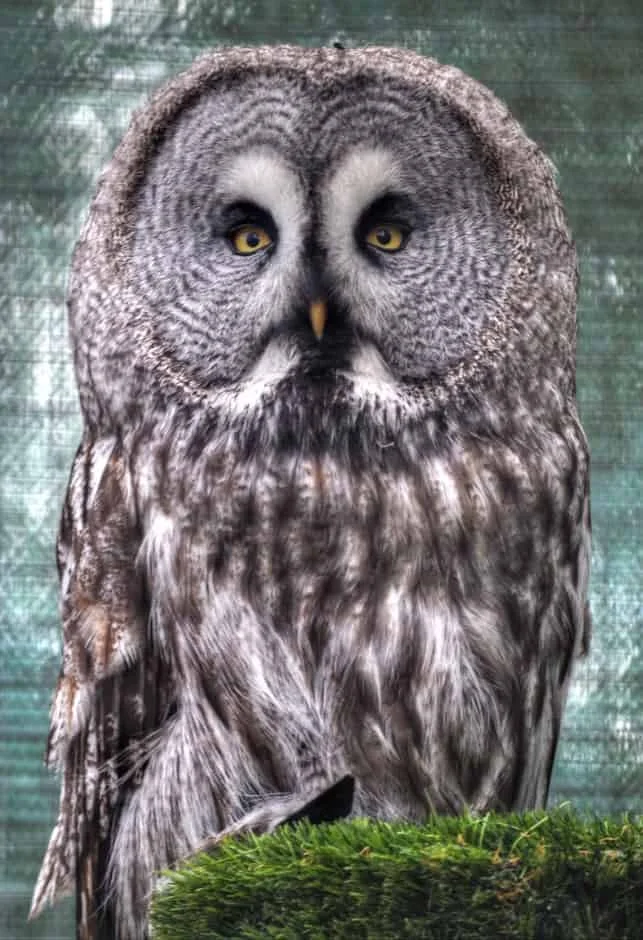
Wingspan
Up to 152cm
Weight
1.1 kg
Life Expectancy
12 years old
Diet
90% small rodents
These birds are one of the tallest species of owls to exist.
As you can expect from the name, these owls are mostly a silvery grey colour, but they can vary in shades including brown feathers.
These birds primarily hunt in meadows which is where you are most likely to see them.
These owls are most likely to hunt during the day when they have nestlings or during the winter months when prey is less abundant.
It appears as though Great Grey Owls form monogamous and long-term breeding pairs, but the individuals do not stay close to one another outside of the breeding seasons. However, compared to many other owl species there is not as much known about the Great Grey Owl.
These owls can be seen in the central and southern regions of Alaska and they are present in the state throughout the whole year.
Some leave the state in the winter months and most of the recorded sightings of this bird have been in the eastern half of the state.
8. Boreal Owl
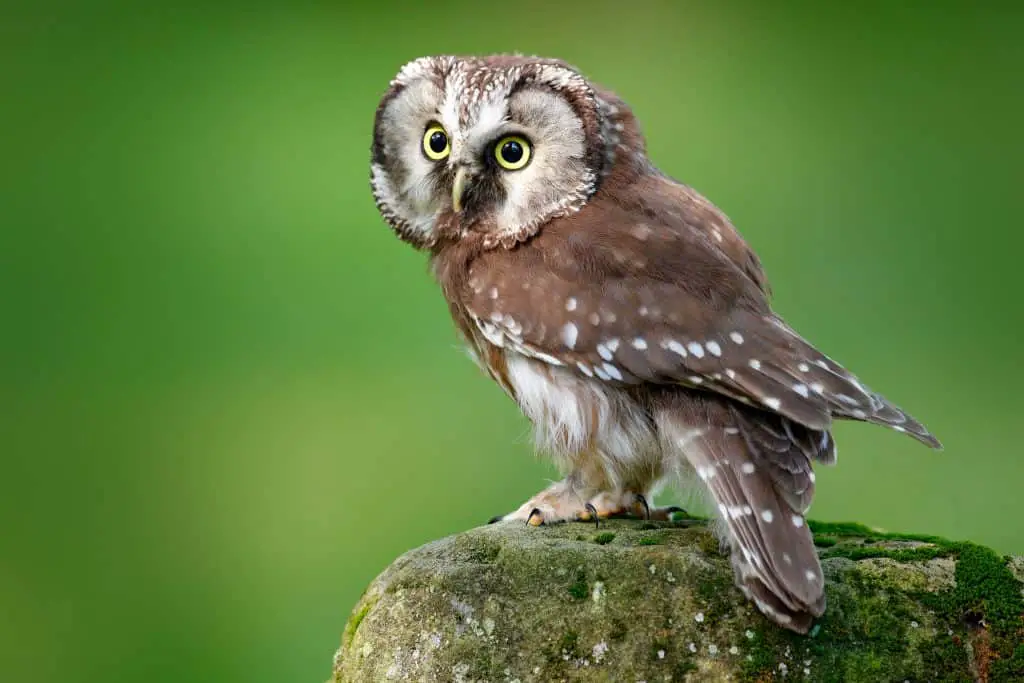
Wingspan
50–62 cm
Weight
120 g
Life Expectancy
16 years
Diet
Small mammals, birds & insects
The Boreal Owl is a small species of owl that has a square-shaped head and no visible ear tufts.
They have short tail feathers and it has a stocky body. Their feathers are a rich brown colour and they have white spots on their backs and white streaks on their belly.
Boreal owls are very solitary owls and even though they form breeding pairs, they do not roost together.
They will only interact for courtship, mating and feeding. These birds are monogamous, but the breeding pairs that they form are not long term.
Males will act to defend their territory, but usually only the area closest to the nest cavity.
They will defend it will a series of calls and songs. These birds like to stay in a variety of woodlands and in America will often stay in woodland areas that are close to mountain ranges.
These owls have a range that extends to the southern and central regions of Alaska and they can be seen in the state throughout the year.
Most of the sightings of this bird have been recorded in the central areas of the state.
9. Northern Pygmy Owl
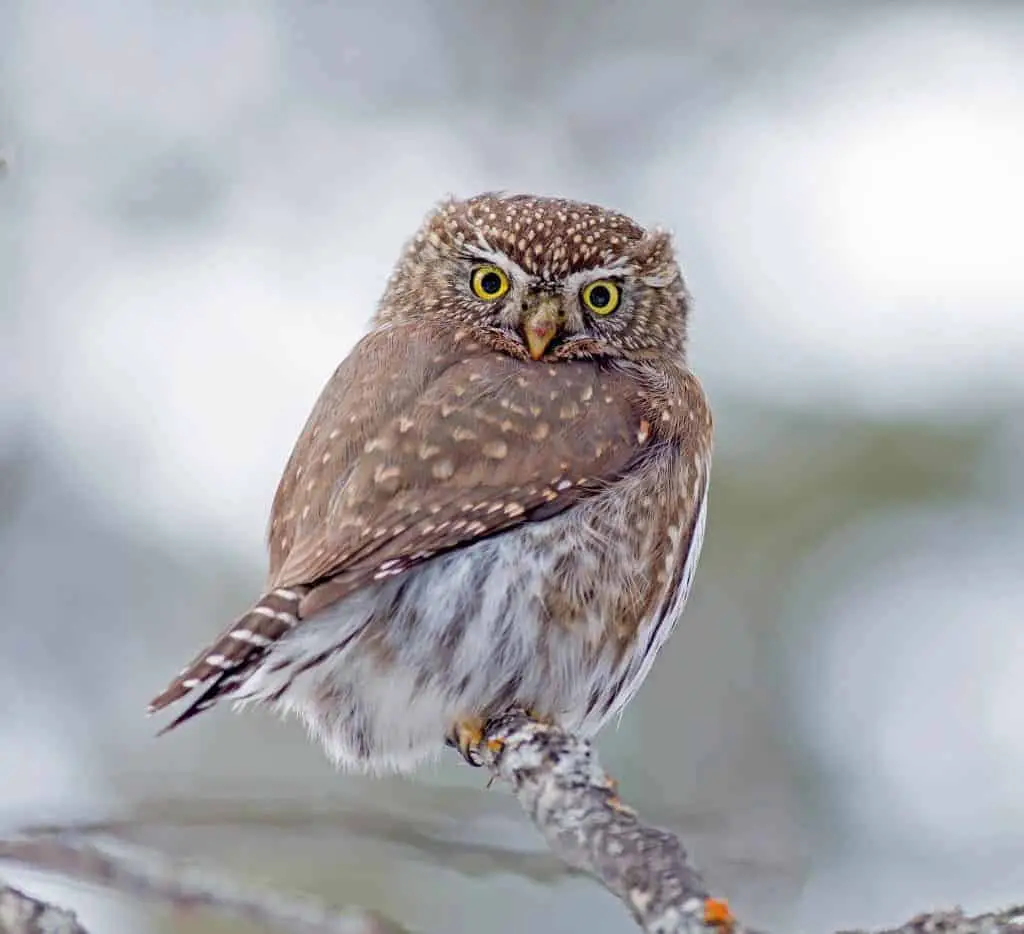
Wingspan
15 inch
Weight
2.25oz
Life Expectancy
6-7 years
Diet
Small birds
The Northern Pygmy-Owl is an adorable species of owl that is known for its spherical head and body.
They are one of the smallest species of owl known to man and are one of the only owls that may use garden bird feeders.
You are most likely to see one of these owls in thickly wooded areas, but they have also been known to move into suburban towns during the winter months.
Due to the fact that they are often preyed on by bigger species of owls, these birds hunt during the day to avoid confrontations with most night-hunting owls.
During the breeding season, males have a unique tooting call which they will use to attract females to their nest.
These birds are monogamous, and males will help the females raise the brood. However, it is unknown as to whether these breeding pairs are long term or if they change every year.
As you may expect, this owl is only seen in the northern states including Alaska.
These birds can be seen in Alaska throughout the whole year and their range consists mainly of the central state regions.
They have most frequently been sighted in the southeastern corner of the state.
10. Barred Owl
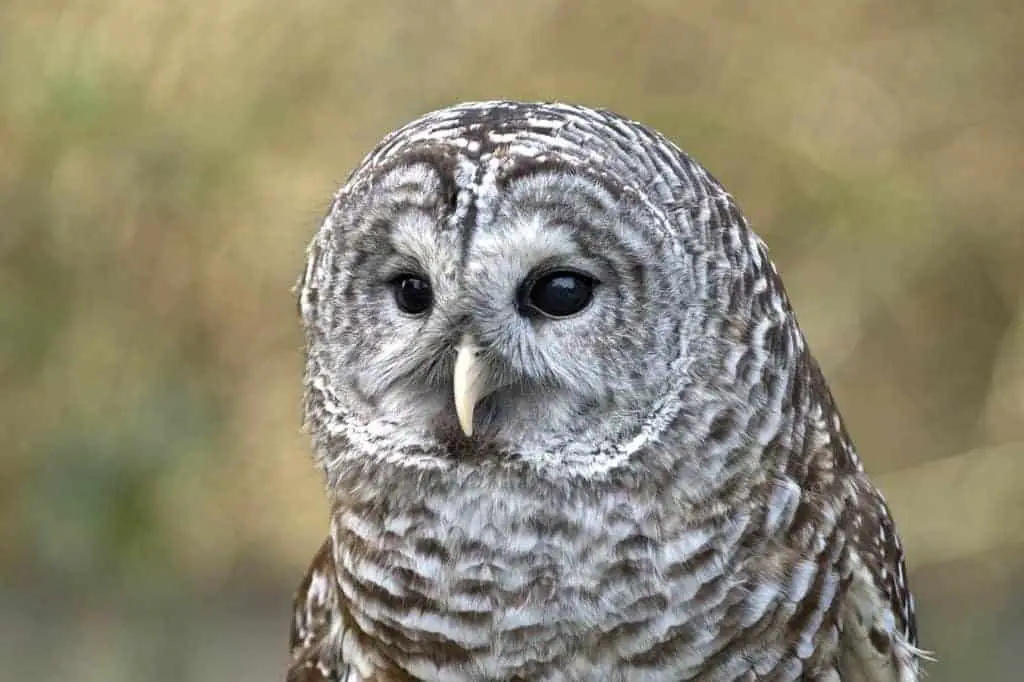
Wingspan
96-125 cm
Weight
468-1,150 g
Life Expectancy
10-23 years
Diet
Small mammals
The Barred Owl has a distinct patterned feathers that cover its body in a series of bars which is where it gets its name.
These bars are usually brown and white in color and are most obvious on the belly and wings of this bird.
Their habitats are usually close to areas of water and include a variety of woodlands. These areas can range from swamps to coastlines.
Like many owl species, Barred Owls will only hunt at night and roost during the day.
Barred Owls are common prey for a variety of species including the aforementioned Great Horned Owl, though they are predators to a lot of smaller bird species, such as woodpeckers.
Sometimes when humans come too close to a Barred Owl’s nest they have been known to sometimes attack or flee, leaving their nest and eggs to be mobbed by smaller species of birds.
These birds are year-round residents in the state of Alaska, but they can only be seen in the far south of the state.
They have only been seen in the small section of islands on the Gulf of Alaska.

More Articles.
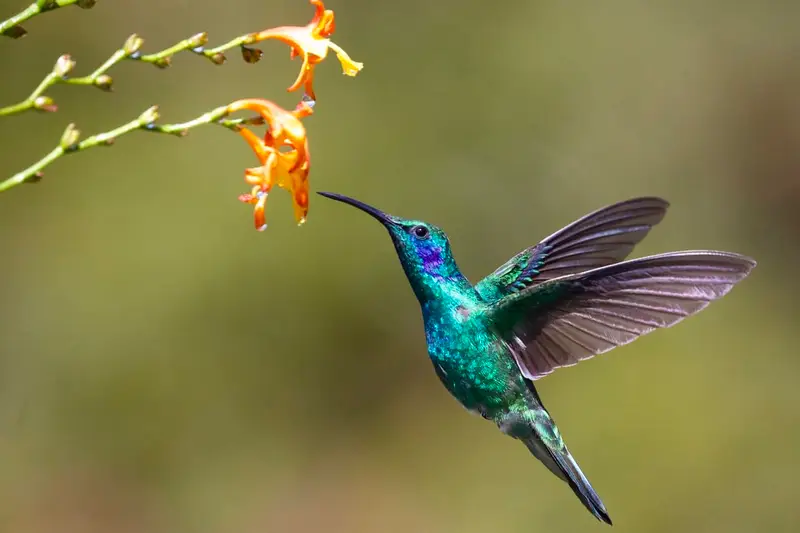
What does it mean to see a Hummingbird?
The hummingbird is easily one of the most celebrated birds in any area. Be it
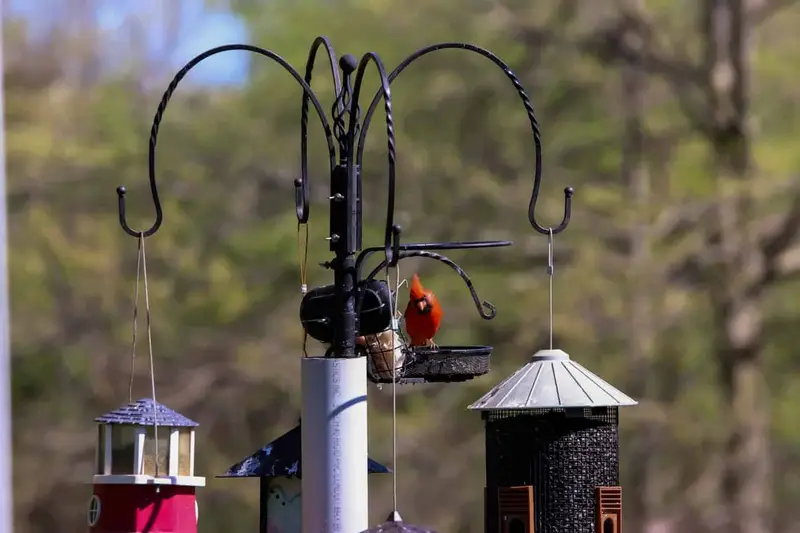
When you are looking to buy bird feeders, you will inevitably be met with recommendations
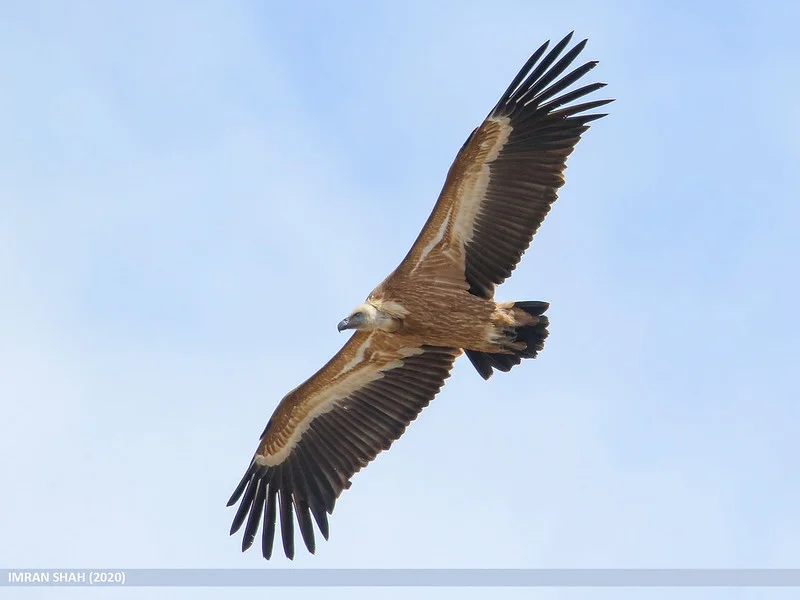
What Birds of Prey can be seen in France? (10 Species with Pictures and Sounds)
France is filled with numerous birds of prey. Its variable habitat from the mountains of

About Us
We are avid bird-watchers who recently retired, allowing us more time to travel the world. Fortunately, we have managed to visit numerous countries around Europe, Asia, and America. Watching and photographing birds has been a passion for many years and we are making the most of the extra time on our hands!

